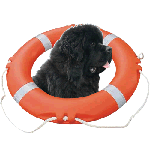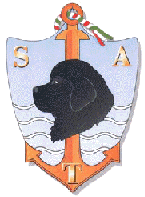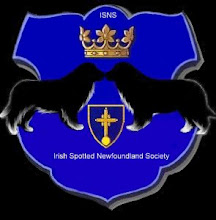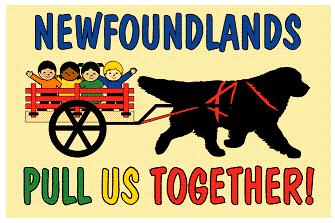Sunday, June 26, 2022
Happy Birthday Andrew
"I wish you were here today
even for just a little while
so I could say Happy Birthday 'Andrew'
and see your beautiful smile.
The only gifts today will be
the gifts you left behind;
The laughter, joy and happiness...
precious memories...the best kind.
Today I'll do my very best
to try and find a happy place...
struggling to hide my heavy heart
and the tears on my face.
I'll sit quietly and look at your picture
thinking of you with love;
hoping you're doing ok
in Heaven up above.
May the angels hold you close and
sing you a happy song...
and I'll be sending wishes to you
today and all year long."
Saturday, June 25, 2022
Dog From Newfoundland Wins Breed At Westminster
(CBC News)
"A dog from a breeding business owned by Newfoundland and Labrador's deputy premier won Best of Breed at the 146th Westminster Kennel Club Dog Show in New York on Wednesday."
"Siobhan Coady, also the province's finance minister, told CBC News the win makes Beau, a Labrador retriever, one of the top dogs in the world.
'To have him here at Westminster, to see him stack up against the best of the best, it certainly is an honour,' Coady said.
Beau, whose full name is Beaumont Hamel, was bred by GoFetch Labradors, the St. John's dog breeding business run by Coady and her husband.
'My husband and I have been breeding Labradors because we wanted to have the best Labradors in the world,' she said. 'They're a heritage animal in Newfoundland and Labrador and they're the best animals in the world.'
The retriever's name holds significance for Newfoundland and Labrador too — Beaumont Hamel is the site in France where more than 700 members of the Newfoundland Regiment were killed, wounded or went missing on July 1, 1916, during the First World War.
Coady said Beau, who was already a grand champion in both Canada and the United States, won the title Best of Breed out of 67 dogs.
He was led to his win by dog handler and co-breeder Fabian Negron, who said he was "thrilled" with Beau.
'Every single box was checked. His attitude was there. His movement was there. He just put on a fantastic performance and the judge recognized it,' he said.
Negron said the Best in Breed title is "amazing recognition" for Beau, as well as for his owners and breeders.
'We're just very excited and we just want the people of Newfoundland to know how proud we are to be representing the breed with one of their own,' Negron said.
Coady owns Beau's mother, Jersey, and Negron owns his father. Despite his world-champion status, Coady said Beau is 'a sook.'
'He's a lovely, kind, sweet dog. He's a typical Labrador retriever. He likes to swim and likes to fetch. He likes to sleep. He likes to give kisses. He's a really kind and gentle soul,' Coady said.
Coady said Beau will be featured in a dog show in Bay Roberts this summer."
Sunday, June 19, 2022
For Henry - The Dog From Newfoundland
THE LEGEND OF THE NEWFOUNDLAND DOG
"There is a land where the waves explode upon the reef in a boiling foam, there the legend was born. As the story is told, God turned one day to contemplate all of his creations and saw on that Newfoundland Isle, flailed by storm a small nation of fishermen, whose rough, weather-beaten people fought courageously against the impervious elements of nature as the freezing cold winter and the unforgiving coastline took its toll, and the sea often asked the sacrifice of human life. Nevertheless, they remained deep-rooted, these men of Newfoundland with the stubbornness as great as their courage. God saw, and in his infinite compassion, thought how he might alleviate their suffering. He searched among the creatures of his creations but found none that would serve. It was then he decided to create one anew. He took the body of a bear, whose bone structure lent well to such arduous labours and whose thick fur would resist the bitter Newfoundland cold. Then he thought to sweeten this silhouette with the lithe, flexuous lines and movements of the seal, with all its prowess to swim and speedily slip between the waves. Now turning to the sea, he saw the playful dolphins happily following the ships, their sweet, joy-filled eyes revealing their serene temperament, and more; they so love man that they often rescue them, saving them from the sea. Yes, they too would be part of this creature. When he had done the moulding and casting, there suddenly appeared in his creative arms, a superb animal with glistening black fur; powerful and sweet in the same moment. This new being, however, had to have an allegiance and faithfulness, tried and true, to be able to live beside man and be ever ready to offer his life for his master. It was at that moment that the Lord opened and placed in his chest, the heart of a dog, and the miracle was complete. From that day onward, those men of the sea had beside them, their courageous companion ever strong, ever faithful, the Newfoundland Dog." (Reprinted in translation from the book "Il Cane Di Terra Nova" by Emmy Bruno, editor Mursia-Milano)
Saturday, June 4, 2022
The Newfoundland - Swimming, Italy, And The Wonder of Dogs With Lynne Cox
(sierranevadaally.org)
"Lynne Cox has seen a lot over the more than 35 years as an amateur, record-setting long-distance and cold water swimmer. Cox has swum in places like the Bering Strait, the English Channel, and Antarctica, writing about it all along the way. Now, her newest book, Tales of Al: The Water Rescue Dog, brings the reader to the coast of Italy, where Cox traveled to Scuola Italiana Cani Salvataggio – the School of Italian Water Rescue Dogs – to meet with the dogs and the trainers who prepare them.
Published May 24, Cox is currently on a book tour to promote Tales of Al. She’ll be headed to Reno for an event at Sundance Bookstore on Wednesday, June 8 at 6pm. For a taste of what the June 8 reading will look like, take a look at the conversation I had with Cox about her travels to Italy, the writing process, and the wonders of dogs, below.
Claire Carlson (CC): Tales of Al’s first chapter is about your childhood and relationship with your childhood dog. Why did you choose to start this story here?
Lynne Cox (LC): I grew up in a swimming family. Everyone, including our family dog Beth, a Dalmatian, knew how to swim. We all spent hot summers at our grandparent’s cabin in Maine, swimming together. So I thought it was really important to show this early influence of swimming with dogs and how much fun it was and how much we loved to do it. My parents were so supportive and gentle with us in the water and made sure we felt safe and learned to coordinate our arms and legs and as we are able to gain strength they let go of us. They taught Beth the same way. So now years later, I’ve watched people work with children and adults learning to swim and dogs and I’ve seen people being taught or children or dogs taught in a rough way, in a way that often scares them where they’re just thrown into the water and expected to swim. And I really disagree with that. I don’t think you should terrify a child or adult or a dog. And so that was part of my reason for being intrigued with how the dogs are being trained at the School of Italian Water Rescue Dogs and how they are able to eventually become athletes that are involved in water rescue.
CC: Your next chapter goes to present(ish) day of you watching a video of a Newfoundland dog from the School of Italian Water Rescue Dogs jumping out of a helicopter to rescue someone. Shortly after watching this video, you booked a trip to Italy. Can you tell me a little bit more about that decision, which seems like such a huge thing to do so spontaneously?
LC: I saw this video and I watched it again and again and just marveled at the courage of these dogs, these Newfoundlands and – I later found out – it wasn’t just Newfoundlands, but Labradors and Golden Retrievers and German Shepherds and Leonbergers and Italian Spinones. How did they fly in helicopters and how did they learn this and how were they not afraid? I just started thinking, you know, I have to find out more about this. I was really intrigued. I’ve worked with athletes. I’ve been an elite athlete. I’ve coached swimmers who have had really bad experiences. And so I wanted to see if the dogs in Italy were being trained because they wanted to learn to swim, they wanted to participate or if they were being forced to do this. I also really admired the thought behind it of people spending time with their dogs to train them to help lifeguard and patrol the coast of Italy, and also Switzerland and Germany, which they go to as well. The video was an immediate inspiration because I love dogs, I love swimming, I love swimming with dogs, and I really wanted to see how they train the dogs at the school.
CC: You mentioned not agreeing with that fear-based approach to learning how to swim, and I think this message really comes through in the book. There’s a part where you talk about courage and what that means to different people, and how it was reflected in the dogs and trainers. Can you speak a little about this and the relationships you formed with the folks you met?
LC: There was this amazing amount of trust that had been established between the dogs and their owners. And part of that was from positive reinforcement, from being so consistent, from realizing that if a dog reached a certain skill but then didn’t understand what to do, they would then back away and not force the dog to reach the next level, because they might not get it and then fail. So the whole philosophy was about building on success, and that success built competence and companionship and trust between the owner and the dog. And so it was really fantastic to suddenly be welcomed into this group. It was like if you’re on a team, any sports team, and you’re suddenly welcome to join them. There’s a sense of how lucky I am to be here. And that’s how I felt in Italy with the people and the dogs from the school. They were eager to answer questions and show me what they were working on and what the dogs had learned and what the instructors or the owners were doing. For somebody who’s curious and wanting to know about cultures and about dogs and about the world, I just felt like oh my gosh, this was such a great idea to just follow curiosity and go to Italy and participate.
CC: I want to zoom out and talk more about the writing process involved in this. When you went to Italy, you met these amazing people, these amazing dogs. Did you go into the experience thinking this would make a great book? How did this all come about?
LC: Well, I actually was there about 10 years ago, and then I came back [to the U.S.] with the idea of okay, maybe I could write something about it. And then I started writing the book, and I didn’t like anything that I was doing. So I just put it aside and worked on other projects, other books. And then the pandemic happened and we had to isolate, and I started reflecting on how extraordinary the experience had been in Italy. And I just thought well, maybe this could be a story. So I started to write, and then it started reminding me of so many things in my life that related to it, and as I talked with my friends about it they mentioned things that had happened in their lives and how this story connected with them. And then I wrote the book.
CC: Lastly, I wanted to ask about the inspirations you drew from writing Tales of Al. The epigraph of the book is a line from Mary Oliver’s Dog Songs: “Because of the dog’s joyfulness, our own is increased. It is no small gift.” What influence has she had on your work?
LC: I love Mary Oliver’s poetry. I love the way she writes about dogs. I love what she writes about life and nature and hope. I’ve read a lot of her work and she reminds me a lot of Robert Frost, but I think she has a little bit more uplift to her poetry. She’s written a number of poems about dogs and I just thought what she expressed in that single sentence is the way so many of us who love dogs feel about dogs, how they multiply our joy and how that is not a little thing. It’s really a very special, almost miraculous thing, you know?"
Subscribe to:
Posts (Atom)











































